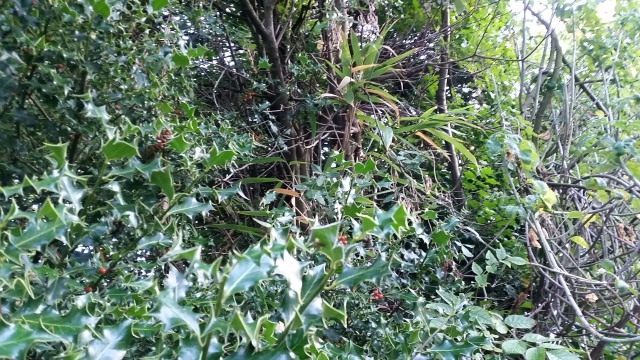What does it tell us: holly and bamboo growing side-by-side here in a garden in southeast England? [Picture taken this morning, near London. Not my garden, by the way…]

It speaks to me of wealth, not only the financial wealth to buy and cultivate exotic plants (while the ring-necked parrot now flies freely over London parks, alongside native crows and magpies), but also the wealth which comes from a mild climate, a generous climate which imposes no extreme frost, no extreme heat, nor drought. Thanks to the Gulf Stream, this blessed, Atlantic bit of Europe is temperate, and wet, and relatively wealthy.
I think we often do forget this type of wealth: a climate which doesn’t kill us, nor even make us suffer much (moaning about the rain does NOT count!). A temperate climate is not financially harsh. We can grow food for ourselves, and for export. We have long been able to grow enough to free many people from the land to pursue other lives.
Meanwhile, humans in general – and developed-world people in particular – have the technical know-how to warm ourselves in inhospitable cold, to cool ourselves in inhospitable heat, but that does cost. On the aforementioned temperate isle of Britain, many wet summers, and many mild winters, have meant we don’t have to pay for air-conditioning, or heating, and therefore we avoid fuel poverty. If you disagree, just look at what happens in a UK heatwave: shops sell out of cheap fans and air conditioners. People save the cost of operating air-conditioning most years, and are wealthy enough (= have enough disposable income) to buy them for a short-term heatwave. In a cold snap, similar happens with heaters: people buy up high-energy electric and halogen heaters and place them in badly insulated houses and flats…. because they have accumulated enough wealth to splash out on high-cost heating, rather than investing even more – long-term – on proper insulation.
I explain elsewhere why I started on climate change as a path into an alternative history, but I come back again and again to the disorientatintg wonder of uninhabitable zones, zones of poverty due to climate factors, and the search for efficiency, which drove so much investment and desire and experimentation during the Ages of Englightenment and industrialisation in the developed world.
To see temperateness set on its head (and foreign AND native species driven out of Northern Europe); to see proud Albion shivering and suffering disrespect by the wealthy Mediterranean powers of Spain, France and Italy; and to see the costs of defiance…
IN A BRIGHT GLASS
In an alternative nineteenth century Italy, a crippled Anglo-Welshman has sold himself into a second indenture to learn the craft of “burning lenses” and bring an inheritance of Mediterranean warmth back to icy England and Wales.
When his master’s rat-like son tries to buy his way out of disgrace by offering the lenses to a powerful patron, Llewellyn-Gareth faces losing everything he has worked for.
Yet when an offer of help does come, it seems the cost may be his inheritance at home, too.
– Amazon US
– Amazon UK
– Amazon Australia
– Amazon Canada
– Barnes & Noble
– Kobo
…and also the Apple iBook store
“THE ELECTRIC GINGERBREAD HOUSE,” in STEAMPUNK FAIRY TALES: VOLUME II
Why must the woodcutter’s children leave the forest, and why is the temptation of the witch’s “gingerbread house” necessary?
– available in e-book format through Amazon, and forthcoming in paperback

